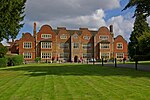Westcott, Surrey
Mole ValleyUse British English from June 2016Villages in Surrey

Westcott is a semi-rural English village and former civil parish 1.5 miles (2.4 km) west of the centre of Dorking on the A25 between the North Downs and Greensand Ridge, making it one of the 'Vale of Holmesdale' villages (greatly in Westcott an AONB) and is in Surrey in the direction of Guildford. It is served by a local bus service and is 1 mile (1.6 km) from Dorking West railway station on the North Downs Line.
Excerpt from the Wikipedia article Westcott, Surrey (License: CC BY-SA 3.0, Authors, Images).Westcott, Surrey
Broomfield Park, Mole Valley
Geographical coordinates (GPS) Address Nearby Places Show on map
Geographical coordinates (GPS)
| Latitude | Longitude |
|---|---|
| N 51.224 ° | E -0.362 ° |
Address
Broomfield Park 9
RH4 3QG Mole Valley
England, United Kingdom
Open on Google Maps








